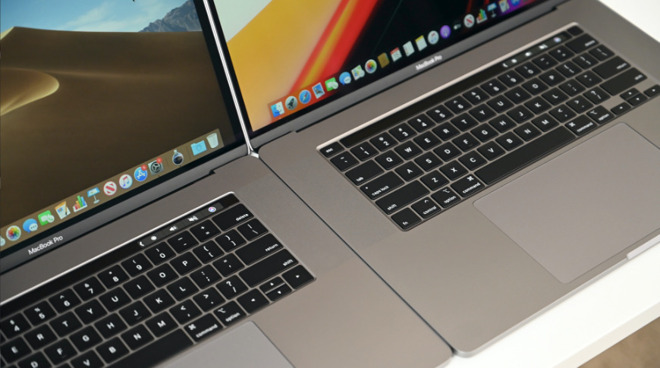Two MacBook Pro models getting mini LED in 2021, MacBook Air in 2022 says Kuo
Apple analyst Ming-Chi Kuo believes that as part of Apple's mini LED push, the company will release a pair of new MacBook Pro models in 2021 with the technology -- and a "more affordable" MacBook Air in 2022.

In a note to investors, seen by AppleInsider, Ming-Chi Kuo is refining his predictions for Apple's use of mini LED technology in the Mac. Specifically, he predicts that the long-rumored 14-inch MacBook Pro with a redesigned chassis will arrive in 2021 alongside another model. Perhaps more notably, Kuo is also expecting a new and "more affordable" MacBook Air in 2022 -- but he didn't comment on the possibility of an enclosure redesign of that model.
Mini LED is, as the name suggests, a very small LED component. While current LEDs are used for backlighting systems, they typically rely on a small number of LEDs lighting up a larger area. Mini LED changes that by allowing more of them to be installed throughout the backlight layer.
The result is a backlight that is extremely evenly lit and could offer higher levels of contrast by dimming darker areas of the screen. This could allow for extremely high contrast displays to be created while still relying on the relatively mature and cost-effective LCD technology rather than switching to the expensive OLED.
Kuo believes that while mini LED panels are more expensive, it won't increase the cost of products that implement the technology. The analyst says that "the use of Apple Silicon can offset the increased cost of using mini LED panels."
Apple generally sticks with a form-factor for between four and four and a half years. The existing MacBook Pro form factor shipped in late 2016 and is still in use with the existing 13-inch Apple Silicon MacBook Pro. The previous chassis debuted with the 2012 Retina MacBook Pro and remained in service until the arrival of the 2016 refresh.
In September 2019, Kuo proposed Apple would produce high-end models of the iPad Pro, and MacBook Pro that uses Mini LED screens produced by LG Display. At the time, Kuo speculated the models would launch in late 2020 or early 2021.
A follow-up note to investors in March 2020 reiterated the potential use of Mini LED sometime in 2020 and said that three iPad models using the technology were coming, along with a refreshed 27-inch iMac Pro, an updated 16-inch MacBook Pro, and a 14.1-inch Mini LED MacBook Pro replacing the 13-inch model.
Wednesday's report is Kuo's first suggesting a new, lower-cost MacBook Air is coming in 2022.
Additionally, in Wednesday's note, Kuo believes that MacBook Air and MacBook Pro shipments will "grow significantly" and double within three years to around 30 million units per year. Factors leading to the increase include Apple Silicon and the long-rumored redesign of the model.
Kuo also predicts Apple to launch two to three new chargers in 2021, potentially expanding fast-charging tech for its mobile device lineup.

In a note to investors, seen by AppleInsider, Ming-Chi Kuo is refining his predictions for Apple's use of mini LED technology in the Mac. Specifically, he predicts that the long-rumored 14-inch MacBook Pro with a redesigned chassis will arrive in 2021 alongside another model. Perhaps more notably, Kuo is also expecting a new and "more affordable" MacBook Air in 2022 -- but he didn't comment on the possibility of an enclosure redesign of that model.
Mini LED is, as the name suggests, a very small LED component. While current LEDs are used for backlighting systems, they typically rely on a small number of LEDs lighting up a larger area. Mini LED changes that by allowing more of them to be installed throughout the backlight layer.
The result is a backlight that is extremely evenly lit and could offer higher levels of contrast by dimming darker areas of the screen. This could allow for extremely high contrast displays to be created while still relying on the relatively mature and cost-effective LCD technology rather than switching to the expensive OLED.
Kuo believes that while mini LED panels are more expensive, it won't increase the cost of products that implement the technology. The analyst says that "the use of Apple Silicon can offset the increased cost of using mini LED panels."
Apple generally sticks with a form-factor for between four and four and a half years. The existing MacBook Pro form factor shipped in late 2016 and is still in use with the existing 13-inch Apple Silicon MacBook Pro. The previous chassis debuted with the 2012 Retina MacBook Pro and remained in service until the arrival of the 2016 refresh.
In September 2019, Kuo proposed Apple would produce high-end models of the iPad Pro, and MacBook Pro that uses Mini LED screens produced by LG Display. At the time, Kuo speculated the models would launch in late 2020 or early 2021.
A follow-up note to investors in March 2020 reiterated the potential use of Mini LED sometime in 2020 and said that three iPad models using the technology were coming, along with a refreshed 27-inch iMac Pro, an updated 16-inch MacBook Pro, and a 14.1-inch Mini LED MacBook Pro replacing the 13-inch model.
Wednesday's report is Kuo's first suggesting a new, lower-cost MacBook Air is coming in 2022.
Additionally, in Wednesday's note, Kuo believes that MacBook Air and MacBook Pro shipments will "grow significantly" and double within three years to around 30 million units per year. Factors leading to the increase include Apple Silicon and the long-rumored redesign of the model.
Kuo also predicts Apple to launch two to three new chargers in 2021, potentially expanding fast-charging tech for its mobile device lineup.


Comments
I wonder how the economics of Apple Silicon work - nominally, the chips could be cheaper than intel chips, but apple also has to foot the entire bill for R&D as well as the costs of ramping up production. Those costs exist with intel, too, but they’re distributed over intel’s entire customer base.
Since they control the entire design, Apple may also be able to optimize integration with other components leading to easier and cheaper system board design/production.
Overall, its definitely cheaper, look at the Mac Mini price if you aren't sure. Since when does Apple lower prices while hurting their margins? The removal of the power brick (of which they NEVER included anything beyond 5W to boost margins) from iPhones comes to mind. That was purely a margin boost.
Will there be a significant price increase to the MacBook Pro 14” with Apple Silicon, or there won’t be any price escalation when compared with the MacBook Pro 13” with M1 chip.
Any suggestion will be of very valuable advice to me in my decision to go for it or wait ... for 2 years I have been waiting with the speculation of Apple Silicon, but when it finally came I am so confused n in dilemma.
The really expensive aspects of making chips, i.e. processes development, manufacturing, etc. are carried by TSMC, not Apple, and distributed across their full range of customers, incl. AMD and others.
It will be interesting to see if Apple, when the inevitable physical boundaries of shrinking structures are reached, will opt to establish its own chip plants to have full control, or if the technology will become sufficiently commoditized that Apple will farm out chip manufacturing to a variety highly competitive companies to further squeeze costs, as they do now with assembly.
I guess the best thing I can say is that Macs hold their value, so if you buy something now and something better comes along, then you can always resell it. However, if your current Mac still works fine, and you don't need a new one, then waiting a little longer to see how this plays out might be the best option. This is only the first step in the transition, so it is still unclear what path has Apple decided to take with these new Macs in hardware design changes, release schedules, SoC variations in performance, etc.
mini LED has been around (it's mostly used for LCD backlighting), Apple even uses it in their XDR displays. Maybe you're thinking of micro LED a technology that's supposed to replace LCD?
The economics of the M-series is intertwined with the A-series. They both share a lot of the same IP blocks. Most additional cost will come from developing new IP blocks unique to the Mac. There isn't much cost in fabricating a new chip design, if it's using an existing production line.
https://www.theverge.com/2020/1/8/21056429/msis-creator-17-laptop-mini-led-1000-nits-hdr-4k
I called that move a long time ago. Once Apple moves to the M2 chip the M1 will become the lower tier, similar to what is done with the iPhone A13 and A14. The only other option would be to make a 12" model. I'm guessing $899 or possibly $849.
I'm willing to bet there's a significant cost savings over INTEL. The much of the R&D and production costs for the M1 come from their investment in Apple Silicon for the iPad, iPhone, AppleTV, Apple Watch and Home Pod. Unlike INTEL they don't have to layer a hefty profit margin on top per/chip since they are only designing for themselves. They also reduced costs by eliminating the need for 3rd party graphics and by moving many of the motherboard components directly into the SOC.
The 16" MBP will have neither the INTEL or AMD tax. We see this same strategy with the iPhone that is rumored to ditch Qualcomm's 5G chip in favor of their own, which will be smaller, cheaper and more power efficient. Don't be surprised to see it inside of the SOC.
The goal from the beginning was to eliminated 3rd party silicon and components, with the exception of common commodity parts like RAM, SSD, and screens, etc. This will result in a more nimble product line with a faster upgrade cycle at a lower cost.
I agree. The design it's a timeless minimal design. Not much could be improved beyond the obvious like a thinner bezel or maybe carbon fiber case or break proof glass (transparent aluminum).